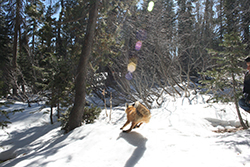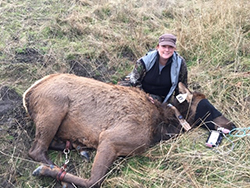
A Sierra Nevada red fox dashes into the wilderness after being caught and released as part of an ongoing CDFW study. CDFW image by Corrie McFarland.

Jennifer Carlson on a Roosevelt elk capture in Humboldt County.
Jennifer Carlson is an environmental scientist with the Wildlife Management Program in CDFW’s Northern Region. Based out of Redding, she is one of two unit biologists covering Shasta and Trinity counties. Her biggest current project is working on Sierra Nevada red fox, a state-threatened species, in the Lassen Peak Region, and she is a member of the long-standing Sierra Nevada Red Fox Working Group. In addition, Jennifer has an elk project waiting in the wings and recently conducted the first helicopter survey in her area to attempt to count the different herds in her unit. Her other responsibilities include responding to human-wildlife conflicts and providing expertise and advice to hunters and the public.
Jennifer received her Bachelor of Science degree in Wildlife Management with a minor in Statistics from Humboldt State University in 1999. She also received her Master of Science in Forestry from Cal Poly San Luis Obispo in 2006. She started her career with CDFW in 2005 in the Timber Harvest Review program in the Northern Region. In 2012, she joined the Wildlife Management Program in her current position. When she is not working, she enjoys spending time with her family skiing, camping, hiking, hunting and fishing.
Who or what inspired you to become a scientist?
My family was instrumental in my inspiration to become a wildlife biologist – particularly my dad. He earned his B.S. in Biology and Chemistry and was a self-taught entomologist. He worked for the department in the 1960s as a scientific aid. But at that time it was difficult to get on with the department as a permanent employee, and he never did get hired. Growing up he would take us on nature hikes and quiz us on all the flora and fauna we saw along the way. His own love of the outdoors started with camping and fishing in the central Sierra Nevada with his grandparents (my great-grandparents) when he was a child and it became a family tradition. It became a summer ritual that we carry on today with my own family – a total of four generations!
What is a typical day like for you at work?
As a unit biologist you don’t always know what the day will hold. When one of the aspects of the job is dealing with nuisance wildlife and the public, you could be getting called out to dart a bear that has found its way into town, or a deer that is stuck in a fence. It can include visiting sites to assess property damage caused by a bear, mountain lion, beaver, or bobcat and issuing a depredation permit. In addition to that there are annual wildlife surveys I am responsible for, including deer, band-tailed pigeons, pronghorn antelope, and elk. I also have special projects I work on and am responsible for overseeing, particularly the Sierra Nevada red fox project in the Lassen Peak area. Running a project from start to finish is very time consuming and takes up a lot of my day, especially during the height of the field season. I help out on other projects that my colleagues run, including capturing and collaring deer and elk, fecal DNA projects on deer and elk, and baited camera stations for mid-size carnivores.
What has been the most challenging, and rewarding aspects, of your study of the Sierra Nevada red fox?
We don’t know much about the Sierra Nevada red fox. We think their numbers in the Lassen area may be less than 20 -- we have a minimum population count based on collaring and genetics of 11 individuals currently. Small populations are difficult to study so this one has been a challenge from the start, and it has been compounded by the rugged terrain and conditions that these foxes live in all year-round. With the snowfall we had this past winter, maintaining functional traps has been a challenge, as has keeping our satellite collars working properly. No matter how much we try to alleviate all the obstacles we anticipate, there will always be a level of uncertainty when working on a wild animal in its natural environment that you must accept as a wildlife biologist. But there are great things we have learned from this project that we didn’t know before. For example, we found and documented the first Sierra Nevada red fox den since the early 1900s. We have some amazing video footage of red fox behavior at the den site as well as vocalizations never heard before. We captured, collared and released back into the wild three females and one male red fox. We documented for the first time an inbreeding event where siblings reproduced and had one pup together. We have also learned that these foxes don’t stay at a low elevation throughout the entire winter, as had previously been thought; instead, they will travel back and forth to the higher elevations around Lassen Peak that we thought they only used in the summer.
Tell us about your upcoming elk study.
The goal of the elk study is to estimate abundance, which is difficult with a wide-ranging species that often uses locations that hinder traditional survey methods. To do this, we will capture and collar cow elk in several different herds to learn their movement patterns and apply two different survey techniques to help estimate abundance. The primary technique will be using a helicopter to survey the different herds and count all individuals sighted in each group – both collared and uncollared. Using this data, you can create a “sight ability” model to estimate how elk many you missed and calculate the population size. The other technique would involve extracting DNA from fecal pellets to identify unique individuals and estimate number of individuals in the population. The satellite radio collars will also give us valuable data on habitat use, resource selection, behavior, disease and cause-specific mortality. This will allow the department to develop a long-term elk monitoring program that our recently released Elk Management Plan outlines for the Northern Region. The project will take place primarily in Shasta County (east of Interstate 5) and possibly Trinity County and will hopefully start in the late fall or early winter of this year.
If you had free reign and unlimited funding, what scientific project would you most like to undertake?
It would be hard for me to pick just one project! I would like to help restore a genetically healthy Sierra Nevada red fox population to its historic range. The Sierra Nevada red fox populations that we have left in the state are severely inbred or their genetics have been compromised by other montane (high-elevation) sub-species and/or non-native individuals that have entered the populations. In the last few years we have learned that there are also Sierra Nevada red foxes in the central and southern Cascade mountains of Oregon, although we don’t know the extent or status of that population. I would implement a translocation project that would move individual foxes from their current population into a new one to facilitate “genetic mixing” and increase genetic health. Once we had genetically healthy populations, then I would like to see them reintroduced into areas that they used to occupy, like on and around Mt. Shasta.
I also would like to undertake a massive elk project that was scientifically sound and robust, with an army of people working on it in the Northern Region. With those resources, we should be able to come up with an accurate population size for elk in our region relatively quickly.
What is the best thing about being an environmental scientist?
One of the best things about my job is that I get to be in the outdoors and explore places I never would have been to otherwise. To be able to study one of the rarest mammals in California, the Sierra Nevada red fox, and provide new information on the life history of this elusive canid has been one of the highlights of my career. Flying in a helicopter counting big game species is something I always dreamed about when I was in college and now I am doing it. Some days I have said to myself, I can’t believe I am getting paid to hike on this trail or fly in a helicopter today!
CDFW Photos. Top Photo: Jennifer Carlson cradles a Sierra Nevada red fox that was captured and collared in the Lassen National Forest. CDFW image by Pat Sater.